-
TPS6220x High-Efficiency, SOT23 Step-Down, DC-DC Converter
- 1 Features
- 2 Applications
- 3 Description
- 4 Revision History
- 5 Pin Configuration and Functions
- 6 Specifications
- 7 Detailed Description
- 8 Application and Implementation
- 9 Power Supply Recommendations
- 10Layout
- 11Device and Documentation Support
- 12Mechanical, Packaging, and Orderable Information
- IMPORTANT NOTICE
Package Options
Refer to the PDF data sheet for device specific package drawings
Mechanical Data (Package|Pins)
- DBV|5
Thermal pad, mechanical data (Package|Pins)
Orderable Information
TPS6220x High-Efficiency, SOT23 Step-Down, DC-DC Converter
1 Features
- High-Efficiency Synchronous Step-Down
Converter With up to 95% Efficiency - 2.5-V to 6-V Input Voltage Range
- Adjustable Output Voltage Range From 0.7 V to VI
- Fixed Output Voltage Options Available
- Up to 300-mA Output Current
- 1-MHz Fixed-Frequency PWM Operation
- Highest Efficiency Over Wide Load Current Range Due to Power Save Mode
- 15-µA Typical Quiescent Current
- Soft Start
- 100% Duty Cycle Low-Dropout Operation
- Dynamic Output-Voltage Positioning
- Available in a 5-Pin SOT23 Package
2 Applications
- PDAs and Pocket PCs
- Cellular Phones and Smart Phones
- Low Power DSP Supplies
- Digital Cameras
- Portable Media Players
- Portable Equipment
3 Description
The TPS6220x devices are a family of high-efficiency synchronous step-down converters ideally suited for portable systems powered by 1-cell Li-Ion or 3-cell NiMH/NiCd batteries. The devices are also suitable to operate from a standard 3.3-V or 5-V voltage rail.
With an output voltage range of 6 V down to 0.7 V and up to 300 mA output current, the devices are ideal to power low voltage DSPs and processors used in PDAs, pocket PCs, and smart phones. Under nominal load current, the devices operate with a fixed switching frequency of typically 1 MHz. At light load currents, the part enters the power save mode operation; the switching frequency is reduced and the quiescent current is typically only 15 µA; therefore, it achieves the highest efficiency over the entire load current range. The TPS6220x needs only three small external components. Together with the SOT23 package, a minimum system solution size is achieved. An advanced fast response voltage mode control scheme achieves superior line and load regulation with small ceramic input and output capacitors.
Device Information(1)
| PART NUMBER | PACKAGE | BODY SIZE (NOM) |
|---|---|---|
| TPS6220x | SOT-23 (5) | 2.90 mm × 1.60 mm |
- For all available packages, see the orderable addendum at the end of the data sheet.
Typical Application Schematic

Efficiency vs Load Current
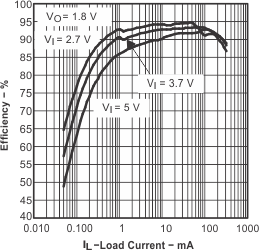
4 Revision History
Changes from E Revision (May 2006) to F Revision
- Added ESD Ratings table, Feature Description section, Device Functional Modes, Application and Implementation section, Power Supply Recommendations section, Layout section, Device and Documentation Support section, and Mechanical, Packaging, and Orderable Information sectionGo
- Changed the format of this data sheet to the new SDA format. No markup for changes. Go
5 Pin Configuration and Functions
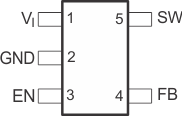
Pin Functions
| PIN | I/O | DESCRIPTION | |
|---|---|---|---|
| NAME | NO. | ||
| EN | 3 | I | This is the enable pin of the device. Pulling this pin to ground forces the device into shutdown mode. Pulling this pin to Vin enables the device. This pin must not be left floating and must be terminated. |
| FB | 4 | I | This is the feedback pin of the device. Connect this pin directly to the output if the fixed output voltage version is used. For the adjustable version an external resistor divider is connected to this pin. The internal voltage divider is disabled for the adjustable version. |
| GND | 2 | — | Ground |
| SW | 5 | I/O | Connect the inductor to this pin. This pin is the switch pin and is connected to the internal MOSFET switches. |
| VI | 1 | I | Supply voltage pin |
6 Specifications
6.1 Absolute Maximum Ratings
over operating free-air temperature range (unless otherwise noted) (1)| MIN | MAX | UNIT | ||
|---|---|---|---|---|
| VI | Supply voltages(2) | –0.3 | 7.0 | V |
| Voltages on pins SW, EN, FB (2) | –0.3 | VCC +0.3 | V | |
| PD | Continuous power dissipation | See Thermal Information | ||
| TJ | Operating junction temperature | –40 | 150 | °C |
| Tstg | Storage temperature | –65 | 150 | °C |
6.2 ESD Ratings
| VALUE | UNIT | |||
|---|---|---|---|---|
| V(ESD) | Electrostatic discharge | Human body model (HBM), per ANSI/ESDA/JEDEC JS-001(1) | ±2000 | V |
| Charged device model (CDM), per JEDEC specification JESD22-C101(2) | ±500 | |||
6.3 Recommended Operating Conditions
over operating free-air temperature range (unless otherwise noted)| MIN | NOM | MAX | UNIT | ||
|---|---|---|---|---|---|
| VI | Supply voltage | 2.5 | 6.0 | V | |
| VO | Output voltage for adjustable output voltage version | 0.7 | VI | V | |
| IO | Output current | 300 | mA | ||
| L | Inductor(1) | 4.7 | 10 | µH | |
| CI | Input capacitor(1) | 4.7 | µF | ||
| CO | Output capacitor(1) | 10 | µF | ||
| TA | Operating ambient temperature | 40 | 85 | °C | |
| TJ | Operating junction temperature | 40 | 125 | °C |
6.4 Thermal Information
| THERMAL METRIC(1) | TPS6220x | UNIT | |
|---|---|---|---|
| DBV [SOT-23] | |||
| 5 PINS | |||
| RθJA | Junction-to-ambient thermal resistance | 220 | °C/W |
| RθJC(top) | Junction-to-case (top) thermal resistance | 125 | °C/W |
| RθJB | Junction-to-board thermal resistance | 36 | °C/W |
| ψJT | Junction-to-top characterization parameter | 14 | °C/W |
| ψJB | Junction-to-board characterization parameter | 35 | °C/W |
| RθJC(bot) | Junction-to-case (bottom) thermal resistance | N/A | °C/W |
6.5 Electrical Characteristics
VI = 3.6 V, VO = 1.8 V, IO = 200 mA, EN = VIN, TA = –40°C to 85°C, typical values are at TA = 25°C (unless otherwise noted)| PARAMETER | TEST CONDITIONS | MIN | TYP | MAX | UNIT | ||
|---|---|---|---|---|---|---|---|
| SUPPLY CURRENT | |||||||
| VI | Input voltage | 2.5 | 6 | V | |||
| IQ | Operating quiescent current | IO = 0 mA, Device is not switching | 15 | 30 | µA | ||
| Shutdown supply current | EN = GND | 0.1 | 1 | µA | |||
| Undervoltage lockout threshold | 1.5 | 2 | V | ||||
| ENABLE | |||||||
| V(EN) | EN high level input voltage | 1.3 | V | ||||
| EN low level input voltage | 0.4 | V | |||||
| I(EN) | EN input bias current | EN = GND or VIN | 0.01 | 0.1 | µA | ||
| POWER SWITCH | |||||||
| rds(ON) | P-channel MOSFET on-resistance | VIN = VGS = 3.6 V | 530 | 690 | mΩ | ||
| VIN = VGS = 2.5 V | 670 | 850 | |||||
| N-channel MOSFET on-resistance | VIN = VGS = 3.6 V | 430 | 540 | mΩ | |||
| VIN = VGS = 2.5 V | 530 | 660 | |||||
| Ilkg_(P) | P-channel leakage current | VDS = 6.0 V | 0.1 | 1 | µA | ||
| Ilkg_(N) | N-channel leakage current | VDS = 6.0 V | 0.1 | 1 | µA | ||
| I(LIM) | P-channel current limit | 2.5 V < Vin < 6.0 V | 380 | 480 | 670 | mA | |
| OSCILLATOR | |||||||
| fS | Switching frequency | 650 | 1000 | 1500 | kHz | ||
| OUTPUT | |||||||
| VO | Adjustable output voltage | TPS62200 | 0.7 | VIN | V | ||
| Vref | Reference voltage | 0.5 | V | ||||
| Feedback voltage (1) | TPS62200 | VI = 3.6 V to 6 V, IO = 0 mA | 0% | 3% | |||
| Adjustable | VI = 3.6 V to 6 V, 0 mA ≤ IO ≤ 300 mA | –3% | 3% | ||||
| VO | Fixed output voltage(1) | TPS62207 | VI = 2.5 V to 6 V, IO = 0 mA | 0% | 3% | ||
| 1.2 V | VI = 2.5 V to 6 V, 0 mA ≤ IO ≤ 300 mA | –3% | 3% | ||||
| TPS62201 | VI = 2.5 V to 6 V, IO = 0 mA | 0% | 3% | ||||
| 1.5 V | VI = 2.5 V to 6 V, 0 mA ≤ IO ≤ 300 mA | –3% | 3% | ||||
| TPS62204 | VI = 2.5 V to 6 V, IO = 0 mA | 0% | 3% | ||||
| 1.6 V | VI = 2.5 V to 6 V, 0 mA ≤ IO ≤ 300 mA | –3% | 3% | ||||
| TPS62202 | VI = 2.5 V to 6 V, IO = 0 mA | 0% | 3% | ||||
| 1.8 V | VI = 2.5 V to 6 V, 0 mA ≤ IO ≤ 300 mA | –3% | 3% | ||||
| TPS62208 | VI = 2.5 V to 6 V, IO = 0 mA | 0% | 3% | ||||
| 1.875 V | VI = 2.5 V to 6 V, 0 mA ≤ IO ≤ 300 mA | –3% | 3% | ||||
| TPS62205 | VI = 2.7 V to 6 V, IO = 0 mA | 0% | 3% | ||||
| 2.5 V | VI = 2.7 V to 6 V, 0 mA ≤ IO ≤ 300 mA | –3% | 3% | ||||
| TPS62203 | VI = 3.6 V to 6 V, IO = 0 mA | 0% | 3% | ||||
| 3.3 V | VI = 3.6 V to 6 V, 0 mA ≤ IO ≤ 300 mA | –3% | 3% | ||||
| Line regulation | VI = 2.5 V to 6 V, IO = 10 mA | 0.26 | %/V | ||||
| Load regulation | IO = 100 mA to 300 mA | 0.0014 | %/mA | ||||
| Ilkg | Leakage current into SW pin | Vin > Vout, 0 V ≤ Vsw ≤ Vin | 0.1 | 1 | µA | ||
| Ilkg(Rev) | Reverse leakage current into pin SW | Vin = open, EN = GND, VSW = 6 V | 0.1 | 1 | µA | ||
6.6 Typical Characteristics
Table 1. Table of Graphs
| FIGURES | |||
|---|---|---|---|
| η | Efficiency | vs Load current | Figure 6, Figure 7, Figure 8 |
| vs Input voltage | Figure 9 | ||
| IQ | No load quiescent current | vs Input voltage | Figure 1 |
| fs | Switching frequency | vs Temperature | Figure 10 |
| Vo | Output voltage | vs Output current | Figure 11 |
| rds(on) | rds(on) - P-channel switch, | vs Input voltage | Figure 2 |
| rds(on) - N-channel rectifier switch | vs Input voltage | Figure 3 | |
| Line transient response | Figure 12 | ||
| Load transient response | Figure 13 | ||
| Power save mode operation | Figure 14 | ||
| Start-up | Figure 15 | ||
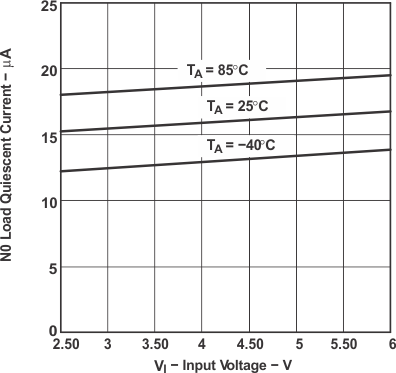
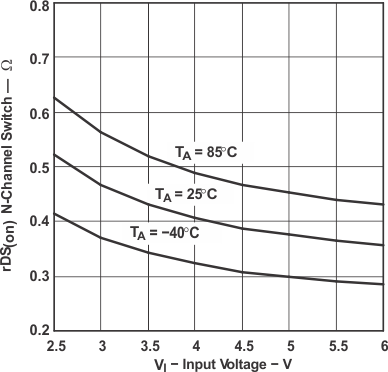
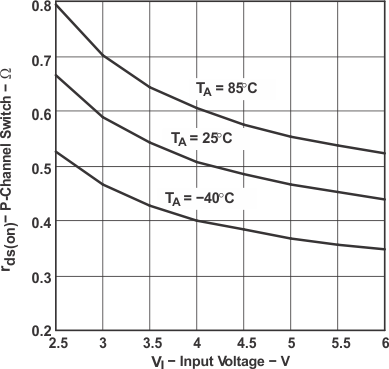
7 Detailed Description
7.1 Overview
The TPS6220x device is a synchronous step-down converter operating with typically 1-MHz fixed frequency pulse width modulation (PWM) at moderate to heavy load currents and in power save mode operating with pulse frequency modulation (PFM) at light load currents.
During PWM operation the converter uses a unique fast response, voltage mode, controller scheme with input voltage feed forward. This achieves good line and load regulation and allows the use of small ceramic input and output capacitors. At the beginning of each clock cycle initiated by the clock signal (S), the P-channel MOSFET switch is turned on, and the inductor current ramps up until the comparator trips and the control logic turns off the switch. The current limit comparator also turns off the switch in case the current limit of the P-channel switch is exceeded. Then the N-channel rectifier switch is turned on and the inductor current ramps down. The next cycle is initiated by the clock signal again turning off the N-channel rectifier and turning on the P-channel switch.
The GM amplifier and input voltage determines the rise time of the Sawtooth generator; therefore any change in input voltage or output voltage directly controls the duty cycle of the converter. This gives a very good line and load transient regulation.
7.2 Functional Block Diagram
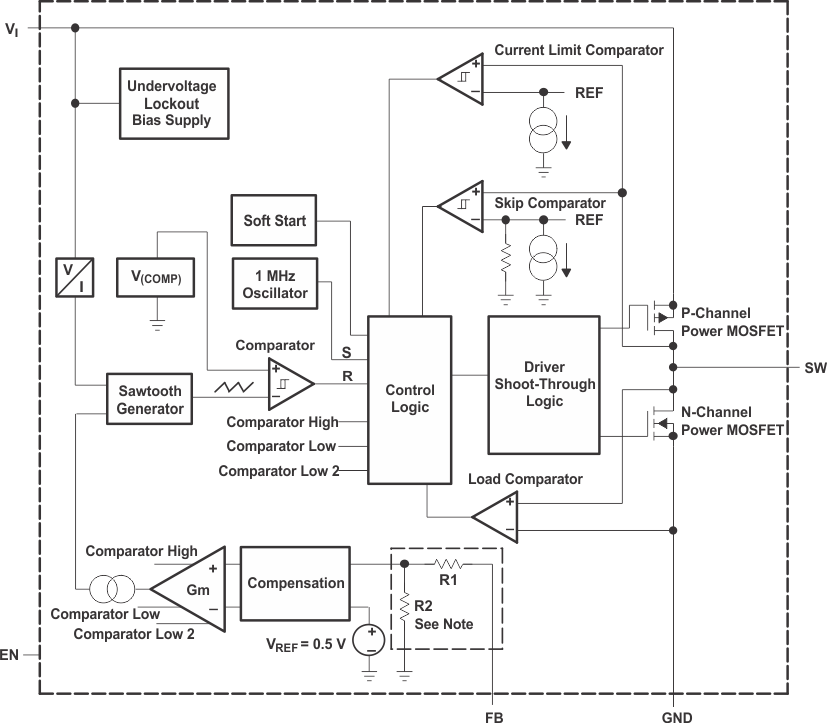
7.3 Feature Description
7.3.1 Undervoltage Lockout
The undervoltage lockout circuit prevents the device from misoperation at low input voltages. It prevents the converter from turning on the switch or rectifier MOSFET under undefined conditions.
7.3.2 Dynamic Voltage Positioning
As described in the power save mode operation sections and as detailed in Figure 4, the output voltage is typically 0.8% above the nominal output voltage at light load currents, as the device is in power save mode. This gives additional headroom for the voltage drop during a load transient from light load to full load. During a load transient from full load to light load, the voltage overshoot is also minimized due to active regulation turning on the N-channel rectifier switch.
7.3.3 Soft Start
The TPS6220x has an internal soft start circuit that limits the inrush current during start-up. This prevents possible voltage drops of the input voltage in case a battery or a high-impedance power source is connected to the input of the TPS6220x.
The soft start is implemented as a digital circuit increasing the switch current in steps of typically 60 mA, 120 mA, 240 mA, and then the typical switch current limit of 480 mA. Therefore the start-up time mainly depends on the output capacitor and load current. Typical start-up time with a 10-µF output capacitor and 200-mA load current is 800 µs.
7.3.4 Low Dropout Operation 100% Duty Cycle
The TPS6220x offers a low input to output voltage difference, while still maintaining operation with the 100% duty cycle mode. In this mode, the P-channel switch is constantly turned on. This is particularly useful in battery powered applications to achieve longest operation time by taking full advantage of the whole battery voltage range. The minimum input voltage to maintain regulation, depending on the load current and output voltage, can be calculated as:

where
- Ioutmax = maximum output current plus inductor ripple current.
- rds(ON)max = maximum P-channel switch rds(ON).
- RL = DC resistance of the inductor.
- Voutmax = nominal output voltage plus maximum output voltage tolerance.
7.3.5 Enable
Pulling the enable low forces the part into shutdown, with a shutdown quiescent current of typically 0.1 µA. In this mode, the P-channel switch and N-channel rectifier are turned off, the internal resistor feedback divider is disconnected, and the whole device is in shutdown mode. If an output voltage, which could be an external voltage source or super capacitor, is present during shutdown, the reverse leakage current is specified under Electrical Characteristics. For proper operation the enable pin must be terminated and must not be left floating.
Pulling the enable high starts up the TPS6220x with the soft start as previously described.
7.4 Device Functional Modes
7.4.1 Power Save Mode Operation
As the load current decreases, the converter enters the power save mode operation. During power save mode, the converter operates with reduced switching frequency in PFM mode and with a minimum quiescent current to maintain high efficiency.
Two conditions allow the converter to enter the power save mode operation. One is when the converter detects the discontinuous conduction mode. The other is when the peak switch current in the P-channel switch goes below the skip current limit. The typical skip current limit can be calculated as

During the power save mode, the output voltage is monitored with the comparator by the thresholds comparator low and comparator high. As the output voltage falls below the comparator low threshold set to typically 0.8% above Vout nominal, the P-channel switch turns on. The P-channel switch is turned off as the peak switch current is reached. The typical peak switch current can be calculated:

The N-channel rectifier is turned on and the inductor current ramps down. As the inductor current approaches zero, the N-channel rectifier is turned off and the P-channel switch is turned on again, starting the next pulse. The converter continues these pulses until the comparator high threshold (set to typically 1.6% above Vout nominal) is reached. The converter enters a sleep mode, reducing the quiescent current to a minimum. The converter wakes up again as the output voltage falls below the comparator low threshold again. This control method reduces the quiescent current typically to 15 µA and reduces the switching frequency to a minimum, thereby achieving the high converter efficiency. Setting the skip current thresholds to typically 0.8% and 1.6% above the nominal output voltage at light load current results in a dynamic output voltage achieving lower absolute voltage drops during heavy load transient changes. This allows the converter to operate with a small output capacitor of just 10 µF and still have a low absolute voltage drop during heavy load transient changes. See Figure 4 for detailed operation of the power save mode.
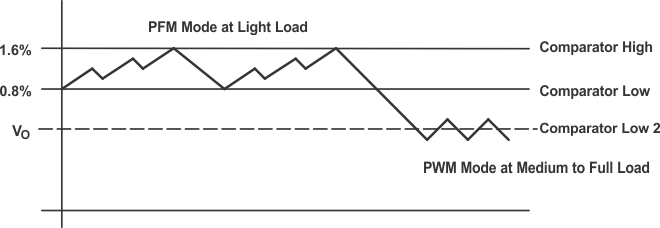 Figure 4. Power Save Mode Thresholds and Dynamic Voltage Positioning
Figure 4. Power Save Mode Thresholds and Dynamic Voltage Positioning
The converter enters the fixed frequency PWM mode again as soon as the output voltage falls below the comparator low 2 threshold.